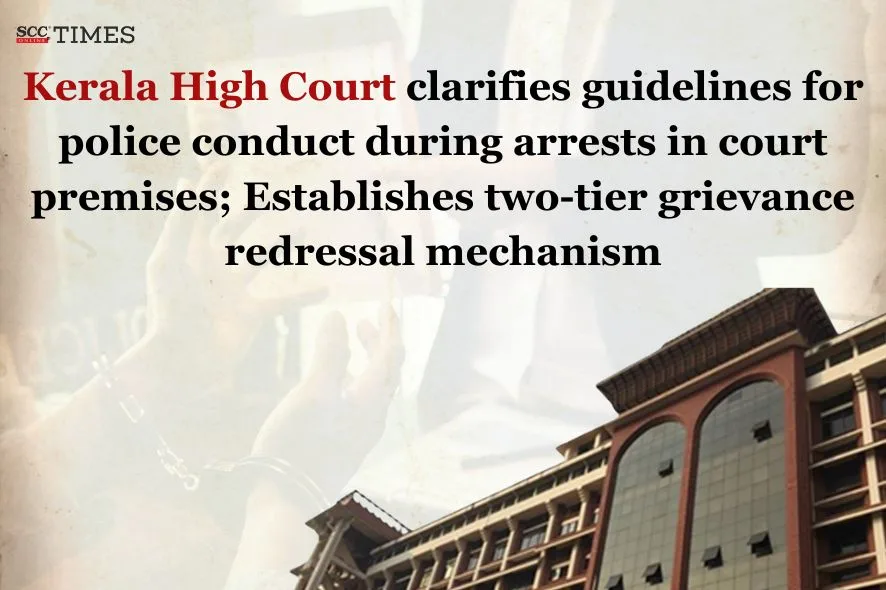Kerala High Court: In a Public Interest Litigation initiated suo motu, based on a letter dated 10-09-2024 from the Kerala High Court Advocates’ Association, the court took cognizance of an incident involving an altercation between an advocate and police officials within the premises of the Judicial First-Class Magistrate Court in Alappuzha District. The division bench, consisting of Dr. A.K. Jayasankaran Nambiar* and Jobin Sebastian, JJ., clarified the guidelines to be followed by police personnel when arresting individuals within court premises in the State. Additionally, the Court directed the establishment of a two-tier grievance redressal mechanism at both the State and district levels. Further clarifications were also provided regarding the report prepared by the State Police Chief on the code of conduct to be followed by police personnel while in court premises.
Background
The Court, taking judicial notice of the rising number of such incidents in the State, felt that guidelines needed to be put in place to address such situations in the future. Accordingly, an order was passed on 20-11-2024, directing the Secretary of the Home Department and the Director General of Police to present before the Court all recent Government Orders, Circulars, and Office Memorandums, if any, issued to police officials regarding the conduct they were expected to follow while attending to proceedings before the Courts and other judicial authorities within the State.
In response to the Court’s directions, an affidavit was filed by the State Police Chief on 06-01-2025, stating that, other than Circulars and Standard Operating Procedures related to investigations and prosecutions, no specific Circular or Office Memorandum had been issued to guide police personnel on conduct during judicial proceedings.
The Court, therefore, felt that it was both necessary and desirable for the State Government to prescribe a Code of Etiquette and Conduct to guide the actions of law enforcement agencies. As a first step towards this, the Court directed the State Police Chief to hold discussions with the Director General of Prosecution to devise a roadmap for further consultations with relevant stakeholders. This process would eventually lead to the publication of a Model Code of Etiquette and Conduct, aimed at guiding police personnel and other law enforcement agencies in the State.
The Court noted that a Model Code of Etiquette and Conduct for police personnel had been drawn up and made available for its perusal through a memo filed by the Senior Government Pleader on 24-03-2025. The Model Code was divided into three parts:
(i) the Code of Etiquette for Police Personnel;
(ii) Standards of Behaviour for the Public and Other Stakeholders towards Police; and
(iii) Standards of Behaviour for Media Reporting on Police-Related Actions.
The Court, finding that the above guidelines were general in nature and that the aim of the proceedings was to develop specific guidelines regarding the code of conduct for police personnel within court premises, directed the State Police Chief to seek suggestions from other stakeholders, including the Bar Council of Kerala, the President of the Kerala High Court Advocates’ Association, and the Director General of Prosecution. The State Police Chief was instructed to then submit a report on the outcome of the deliberations held with these stakeholders on the matter. A report was submitted by the State Police Chief on 04-06-2025.
Analysis and Decision
Upon consideration of the various suggestions, the Court noted that in addition to the statutory and administrative guidelines already in place, such as the provisions of the Bharatiya Nagarik Suraksha Sanhita,2023, the Kerala Police Act, 2011, the Government Orders, and Office Memorandums issued by the State Government, along with the judicial guidelines prescribed in the context of arrests in various judicial precedents, the following clarifications would suffice to guide law enforcement agencies regarding the arrest of individuals within court premises in the State:
-
“Court premises” was defined as not only referring to the courtrooms but also including all lands, buildings, and structures (except residential quarters) used in connection with court proceedings during the notified working hours of the court, or until the court session ended, whichever was later.
-
Guidelines for arrests within court premises:
-
Arrest, detention, or apprehension of any person within court premises during court hours shall, except in situations covered by clause (iii), be done only with prior intimation to the presiding officer or the jurisdictional court.
-
A person intending to surrender before the court in connection with a crime, either by themselves or with a lawyer/advocate, shall not be arrested, apprehended, or detained in court premises without prior permission from the presiding officer or jurisdictional court.
-
Police may arrest or use necessary force to arrest persons in court premises only in emergent situations necessitating immediate action to prevent a cognizable offence within the premises. Police can also arrest absconding persons/accused in long-pending warrant matters. However, intimation of such arrests must be given to the presiding officer immediately after the arrest.
-
-
To establish a two-tier grievance redressal mechanism at the State and District levels, the court referenced judicial precedents in Chalakkudy Bar Association v. Thomas Jolly Cheriyan, 1999 SCC OnLine Ker 193 and District Bar Association Dehradun v. Ishwar Shandilya1. The following committees were to be constituted at the State and District levels:
a) State Level Committee:
-
Advocate General of the St
-
ate
-
Director General of Police
-
Three members of the Bar, nominated by the High Court Bar Association, including its President
-
The Superintendent of Police of the concerned area (or, in cases involving the Superintendent of Police, a senior officer nominated by the Director General of Police)
-
The President of the Bar Association to which the complainant-advocate belongs (except the High Court Bar Association)
b) District Level Committee:
-
Principal District Judge or the Judicial Officer nominated by the Principal District Judge
-
District Police Chief
-
District Government Pleader
-
President of the Bar Association to which the complainant-advocate is a member
-
A member nominated by the Bar Association to which the complainant-advocate is a member
The Court directed that the deliberations of the committees should be held at venues identified as convenient for all stakeholders. Disputes or grievances unresolved at the District Level would be escalated to the State Level Committee for resolution.
The State Government was directed to issue an Office Memorandum immediately to inform all stakeholders about the contents of this order.
The case was posted for further consideration after two months.
[Suo Motu v State of Kerala, 2025 SCC OnLine Ker 6433, decided on 19-08-2025]
*Order by: Justice Dr. A.K. Jayasankaran Nambiar
1. 2023 (4) KHC 233



